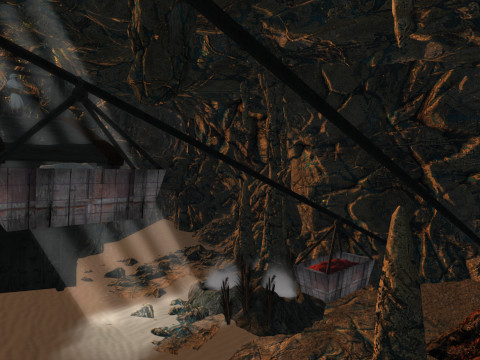In den Salz-Minen
Die Umgebung – also das „unterirdische“ Höhlensystem – stammt von einer anderen Gamedesignerin, aber ich musste das Interieur beisteuern. Die folgende Passage aus Tribesmen of Gor sollte als Environment für Spieler realisiert werden (die Pipelines sind noch nicht fertig):
At Klima, however, most of the salt is in solution. It is the subterranean residue of portions of the vanished seas themselves, which have slipped through fissures and, protected from the heat, and fed still by the ancient seeping rivers, now moving sluggishly beneath the surface, maintain themselves, the hidden remnants of oceans, once mighty, which long ago swelled upon the surface of Gor itself. The salt in solution is obtained in two ways, by drilling and flush mining and, in the deeper pits, by sending men below to fetch the brine.
In the drilling and flush mining, two systems are used, the doublepipe system and the separate-pipe system. In the double-pipe system fresh water is forced into the cavity through an outer pipe and the heavier solution of salt and water rises bubbling through the second pipe, or inner pipe, inserted within the larger. In the separate-pipe system, two pipes, separated by several yards, are used, fresh water being forced through one, the salt water solution, the salt being dissolved in the fresh water, rising through the other. The separate-pipe system is, by most salt masters, regarded as the most efficient. An advantage of the double-pipe system is that only a single tap well need be drilled. Both systems require pumping, of course.
But much of the salt at Klima comes from its famous brine pits‘ These pits are of two kinds, „open“ and „closed.“ Men, in the closed pits, actually descend and, wading, or on rafts, negotiate the sludge itself, filling their vessels and later, eventually, pouring their contents into the lift sacks, on hooks, worked by windlasses from the surface. The „harvesting“ vessel, not the retaining vessel, used is rather like a perforated cone with a handle, to which is attached a rope. It is dragged through the sludge and lifted, the free water running from the vessel, leaving within the sludge of salt, thence to be poured into the retaining vessels, huge, wooden tubs. The retaining vessels are then emptied later into the lift sacks, a ring on which fits over the rope hooks. In places, the „open pits,“ the brine pits are exposed on the surface, where they are fed by springs from the underground rivers, which prevents their dessication by evaporation, which would otherwise occur almost immediately in the Tahari temperatures. Men do not last long in the open pits. The same underground seepage which, in places, fills the brine pits, in other places, passing through salt-free strata, provides Klima with its fresh water.
Was die Sache extrem kompliziert machte: Die Höhlen waren schon fertig, ich musste das Interieur im nachhinein hineinfummeln. Wer das einmal gemacht hat weiß, dass so etwas einen an den Rand des Wahnsinns treiben kann. Außerdem ist die Oase eine Skybox in 3.500 „Metern“ Höhe, das Wasser also nicht das „natürliche“ Wasser von Secondlife, in dem Avatare automatisch schwimmen könne. Es muss gesondert „künstlich“ hergestellt werden. Auf dem Screenshot ist übrigens auch mein Avatar zu sehen.
Kommentare
3 Kommentare zu “In den Salz-Minen”
Schreibe einen Kommentar




















Habe ich eigentlich schon mal erwähnt wie viele Kubikmeter unbewohnte Kali/ Steinsalz- Schächte wir in Deutschland haben.
„Wir haben Platz“
[…] Wie schon erwähnt, statte ich gerade eine Sim in Secondlife aus, die am 2. Oktober eröffnet wird. Thema hier: Solegruben in Salzminen. […]
[…] Höhlen, in denen vor allem rotes und gelbes Salz abgebaut wird. Man transportiert es mit Loren und Flaschenzügen an die Oberfläche. Vorsicht vor den Salzhaien! Ausserhalb der Höhlen findet man noch Solegruben, […]